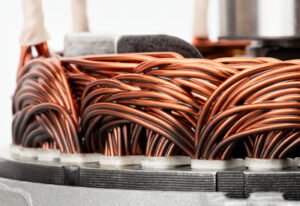Wacker to showcase fast-curing silicone resin at CWIEME
Munich, Germany – WACKER will be attending CWIEME, the international tradeshow for coil winding, insulation and electrical manufacturing, where it will present a new silicone resin specifically developed for the trickle impregnation of electric motors. SILRES® H60 cures rapidly into a heat-resistant and electrically insulating thermoset, thereby making it possible to quickly impregnate the coil winding. What is more, electric motors impregnated with this resin exhibit considerable thermal stability and durability. The new silicone resin is ideal for impregnating the motors of smoke extraction fans and electric cars. CWIEME will be taking place from May 10-12 in Berlin, Germany.
One of the products WACKER is presenting at CWIEME Berlin is the new electrically insulating resin SILRES® H60. This fast-curing, high-tempera-ture-resistant phenyl silicone resin can be used for the trickle impregnation of electric-motor coil windings. (Photo: WACKER)
With its new silicone resin, WACKER is continuing to expand its portfolio of high-temperature-resistant, electrically insulating resins. SILRES® H60 is a two-part phenyl silicone resin that does not contain any solvents or reactive diluents. During a platinum-catalyzed addition reaction, this low-viscosity, ready-to-use resin cures to form a thermoset of the hardness Shore D 65.
What is special about the new resin is its curing speed. Gel time at 150 degrees Celsius is a mere 15 minutes. After a total of six hours at this temperature, the material is fully cured. When an operating temperature of 180 degrees Celsius is used, the gel time drops to five minutes and curing takes just two and a half hours. Consequently, gelling and curing are a great deal faster than is the case with a one-part phenyl silicone resin such as SILRES® H62 C, which has proved its worth in winding impregnation.
The cured material is characterized by excellent electrical insulation properties and withstands long-lasting thermal stress. The thermal resistance of the cured resin corresponds to thermal class R as per EN 60085. This means that the resin can constantly cope with temperatures of up to 220 degrees Celsius. Resistant to aging and weathering, it also has a tack-free and hydrophobic, i.e. water-repellent, surface.
These properties make SILRES® H60 ideal for the impregnation of copper-wire windings. Such windings are found in the stator of many electric motors. Impregnation produces a thin layer of resin on the copper wires, which displaces air out of the gaps between the individual wire layers and out of winding cavities. In this way, impregnation enhances electrical insulation, strengthens the winding, affords protection against moisture and helps to transfer the heat from the winding to the laminated core of the stator. Finally, impregnation not only ensures that the electric motor has a long service life, but also avoids power losses during operation.
SILRES® H60 is a fast-curing resin designed for trickle impregnation. This technique involves trickling the insulating resin on the end turns of the stator coil until the resin is evenly distributed in the entire coil winding. The resin is not only applied, but also cured, in a rapid and automated process. This allows manufacturers of electric motors to impregnate a large number of windings very quickly, which is not possible when conventional dip impregnation or vacuum-pressure impregnation is used. Trickling is mainly used for smoke extraction fans employed, for example, as fire-protection devices in tunnels, and for motors of electric or hybrid vehicles.
The new silicone resin is also suitable as a binder for fiber-based composites, the fiber component of which is composed, for example, of glass, carbon or mineral fibers. In this way, SILRES® H60 can be used in resin transfer molding to make molded fiber-composite parts or in pultrusion to make fiber composite profiles. The silicone resin confers hydrophobic properties on porous materials and fillers such as magnesium oxide. Such hydrophobic treatment can be used to protect tubular heating elements against moisture.

